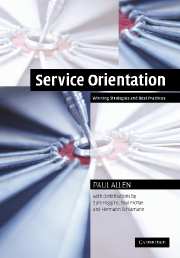Book contents
- Frontmatter
- Contents
- Foreword
- Preface
- Acknowledgments
- List of acronyms and abbreviations
- PART 1 OVERVIEW
- PART 2 BUSINESS ARCHITECTURE
- PART 3 SERVICE-ORIENTED ARCHITECTURE
- 7 Service-oriented architecture themes
- 8 Service-oriented architecture policy
- 9 Service design
- 10 QoS Infrastructure design
- PART 4 SERVICE-ORIENTED MANAGEMENT
- PART 5 CASE STUDIES
- References
- Useful sources of information
- Index
8 - Service-oriented architecture policy
from PART 3 - SERVICE-ORIENTED ARCHITECTURE
Published online by Cambridge University Press: 31 July 2009
- Frontmatter
- Contents
- Foreword
- Preface
- Acknowledgments
- List of acronyms and abbreviations
- PART 1 OVERVIEW
- PART 2 BUSINESS ARCHITECTURE
- PART 3 SERVICE-ORIENTED ARCHITECTURE
- 7 Service-oriented architecture themes
- 8 Service-oriented architecture policy
- 9 Service design
- 10 QoS Infrastructure design
- PART 4 SERVICE-ORIENTED MANAGEMENT
- PART 5 CASE STUDIES
- References
- Useful sources of information
- Index
Summary
Foundations of SOA policy
Recall from chapter 4 that business goals and rules, the BIAT, and sourcing and usage policy are captured as part of the BA policy. Traditional approaches tend to divorce business concerns from IT. In contrast, as we shall see in this chapter, a service-oriented approach involves a very close relationship between business and IT concerns, between BA policy and SOA policy.
Another problem with traditional approaches is that they tend to focus on business functionality and information, and to neglect the area of policy. In contrast, a service-oriented approach emphasizes policy as much as functionality and information requirements. In this chapter, we introduce the policy aspects of SOA along with techniques for capturing and developing that policy in alignment with business needs.
SOA policy aspects
The policy aspect of SOA, shown in overall context in figure 8.1, falls into four parts:
QoS
Design
Sourcing and usage
Technology.
While design, sourcing and usage, and technology all represent critical areas of SOA policy, our view is that progress in each of these areas has been up to now much better than in the case of QoS. To a large extent we can evolve what we already have learned regarding policy in the areas of design, sourcing and usage, and technology. Indeed, very often organizations have no choice but to evolve in a manner that seeks to maximize return on existing assets. Business leaders understandably will have it no other way.
- Type
- Chapter
- Information
- Service OrientationWinning Strategies and Best Practices, pp. 137 - 156Publisher: Cambridge University PressPrint publication year: 2006

